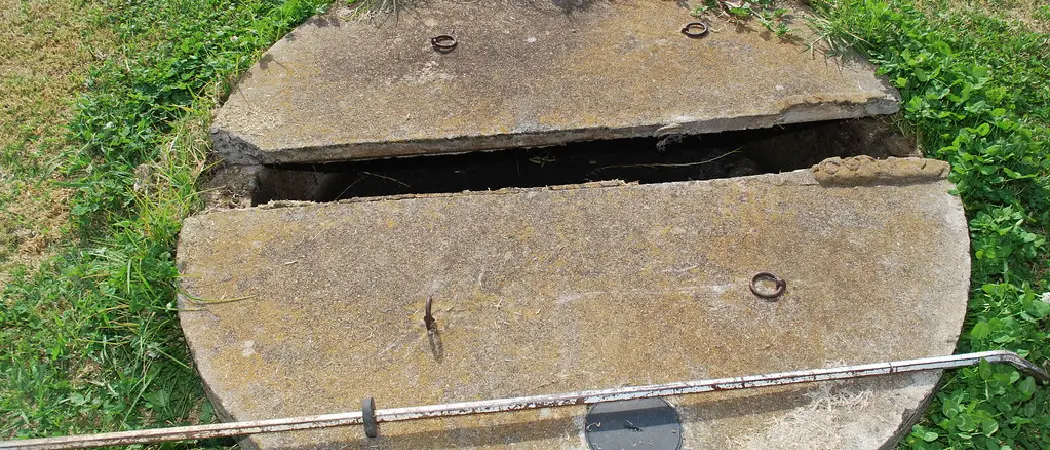We’ve all been there – you’ve spent countless hours perfecting your landscape, but there it is, that unsightly septic tank lid sticking out like a sore thumb.
Not only is it an aesthetic concern, but visible septic tank lids can also negatively impact the value of your property, especially if you’re considering selling. It’s a problem that many homeowners and landscapers face, but the good news is that there are a variety of effective methods to cover and conceal these eyesores.
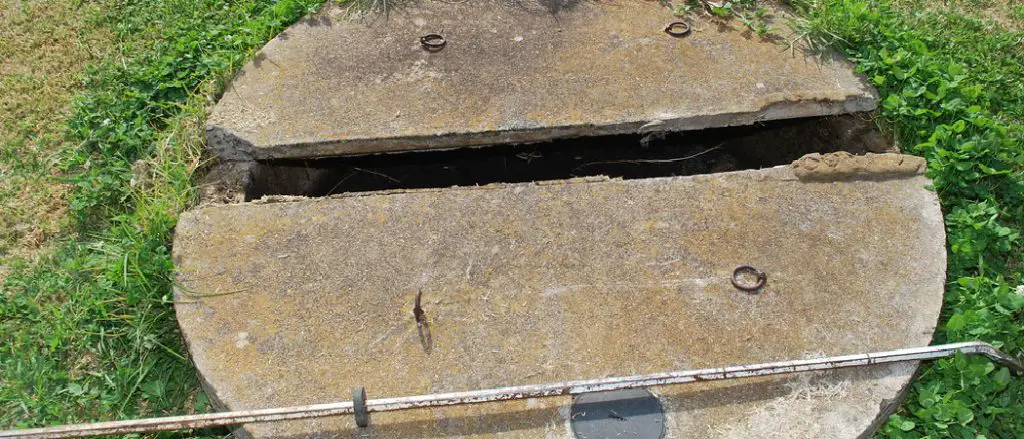
Whether you’re a homeowner looking for a DIY project or a landscaper searching for innovative solutions for your clients, we’ll guide you through several techniques tailored to suit different environments and preferences. So, keep on reading this article about how to cover a septic tank lid.
Why Covering a Septic Tank Lid is Important
Before we delve into the methods of covering a septic tank lid, it’s essential to understand why this step is necessary. Apart from being unsightly, an uncovered septic tank lid can pose several safety hazards, especially for children and pets.
Additionally, leaving the lid exposed to the elements can cause damage over time, leading to costly repairs or replacement. The odor emanating from an open septic tank can also become a nuisance and attract unwanted pests.
Covering the septic tank lid not only helps to maintain your yard’s appearance but also ensures safety and protects the functionality of your septic system.
Types of Septic Tank Lid Covers
There are myriad ways to cover a septic tank lid, and the right one for you depends on your preference, budget, and the level of effort you’re willing to put in. Here, we categorize them into two broad types: Prefabricated covers and DIY options.
A. Prefabricated Covers
Prefabricated covers are manufactured and ready-to-use solutions designed to conceal your septic tank lid effectively.
1. Materials and Designs
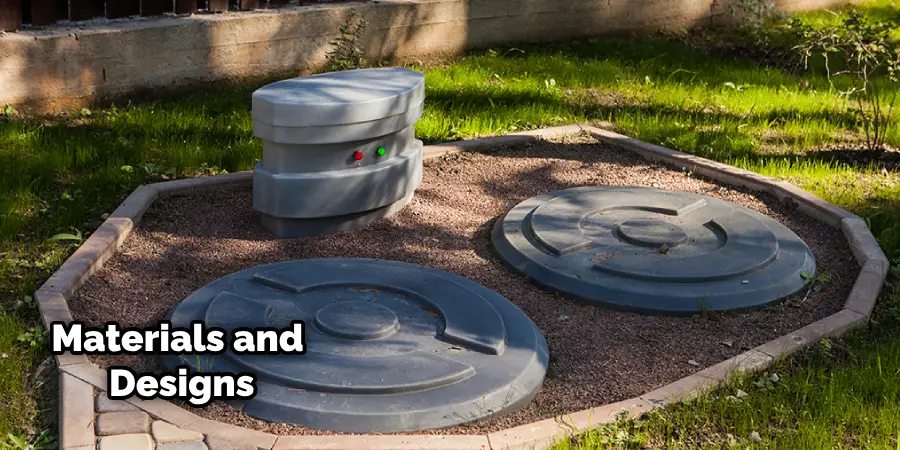
These covers come in a variety of materials, including durable plastic, fiberglass, and concrete. The designs range from simple, functional lids to decorative faux rocks or grass mounds for a more natural look.
2. Pros and Cons
The advantage of prefabricated covers is their ease of installation and variety of designs to suit any yard aesthetic. However, they can be more expensive than DIY options and might not perfectly match the specific size or shape of your septic tank lid.
B. DIY Options
For those who prefer a personalized touch or are on a budget, DIY options can be a great alternative.
1. Concrete Covers
Concrete covers can be tailored to fit your septic tank lid perfectly and painted to blend with your yard. They are robust and durable, but their heavy weight can make access to the tank more difficult.
2. Wooden Covers
Wooden covers, such as a simple deck or bench, can add functional space to your yard while hiding the septic tank lid. They offer flexibility in design but require regular maintenance to prevent rot and pest infestation.
3. Other Creative Alternatives
Other DIY alternatives include creating a garden bed or planting ground cover plants around the lid. These options can enhance the beauty of your yard while cleverly disguising the septic tank. Care should be taken to ensure plants’ roots do not interfere with the septic system.
Safety Considerations When Covering a Septic Tank Lid
While aesthetics and maintenance are significant factors in covering a septic tank lid, safety is paramount. An exposed septic tank lid is not just unsightly but can also be a potential hazard. Children and pets may accidentally fall into an uncovered tank, which can lead to serious injuries or even fatal accidents. Additionally, exposure to the elements and constant foot or vehicle traffic can lead to lid damage, compromising the integrity of your septic system.
Septic tank lids are not designed to bear excessive weight. Overloading them can cause cracks or complete breakage, leading to costly repairs and potential environmental hazards. As such, while it may be tempting to park a vehicle over the lid or build heavy structures, this should be avoided to prevent damage.
Lastly, even while covering the septic tank, easy access for regular maintenance and inspections should be considered. Covers should be secure to prevent accidental entry yet easy enough to remove when necessary. Adhering to these safety considerations will ensure your septic system’s longevity and your household’s well-being.
Assessing Your Septic Tank Lid
Inspecting Your Septic Tank Lid
Before covering your septic tank lid, it’s important to assess its current condition first. This will involve checking for signs of wear and tear and taking accurate measurements for the cover.
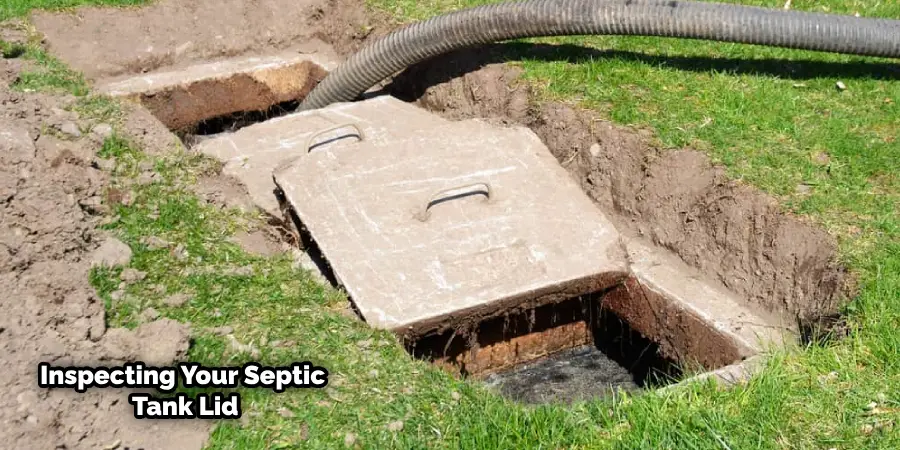
1. Signs of Wear and Tear
Regularly inspect your septic tank lid for any cracks, chips, or other forms of damage. These could be indicators that the lid is starting to fail and may need replacing. A septic tank lid in poor condition is not only a safety concern, but it can also compromise the effectiveness of your septic system. Look for signs of excessive wear, such as discoloration, warping, or erosion. If you notice any foul odors or damp spots around the lid, this could suggest a leak, which requires immediate attention.
2. Measurement Considerations for a Cover
Once you’ve established that your septic tank lid is in good condition, the next step is to measure it accurately for the cover. Note down the precise dimensions – diameter and height of the lid. If it extends above the ground level, the cover should accommodate this elevation. The size of the cover depends on these measurements, so ensure they are accurate to avoid any fit issues later. It’s also a good idea to factor in a bit of wiggle room to ensure easy access for maintenance and inspections.
Creative Ways on How to Cover a Septic Tank Lid
Now that you’ve assessed your septic tank lid and have an understanding of the different types of covers available, it’s time to get creative! Here are some ideas to help you cover your septic tank lid while elevating your yard’s aesthetic.
1. Install a Pergola or Gazebo
Pergolas and gazebos offer a perfect blend of beauty and functionality for your yard. They can be built over the septic tank lid, providing shade and enhancing your outdoor living space while concealing the lid.
2. Create a Rock Garden or Water Feature
A rock garden or water feature can serve as an eye-catching centerpiece in your yard while discretely hiding the septic tank lid. Choose rocks and plants that complement your yard’s overall look for a seamless blend.
3. Design a Patio or Deck
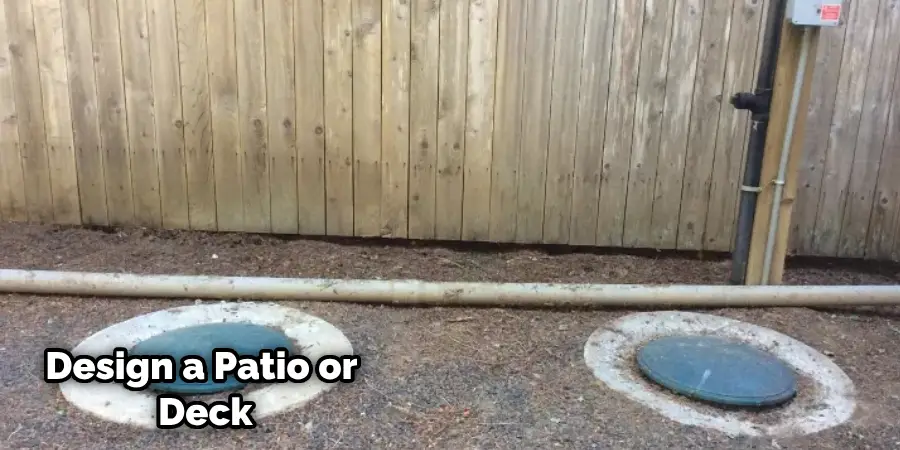
A patio or deck can serve as a functional and inviting space while covering the septic tank lid. Consider adding potted plants, outdoor furniture, and lighting to enhance the area’s ambiance.
4. Build a Fire Pit
A fire pit can serve as a cozy gathering spot for friends and family while cleverly disguising the septic tank lid. You can use various materials, such as bricks, stones, or concrete, to construct it.
5. Use Decorative Mulch or Gravel
Decorative mulch or gravel can be used to cover the septic tank lid and blend it with your yard’s landscaping. Choose colors and textures that complement your existing plants and features for a cohesive look.
Remember, when covering your septic tank lid, ensure there is easy access for future maintenance and inspections.
Selecting the Right Method to Cover Your Septic Tank Lid
Choosing the right method to cover your septic tank lid involves careful consideration of several factors. Here are some crucial points to keep in mind:
Factors to Consider:
- Aesthetics: The cover should blend seamlessly with your yard’s overall look and enhance its beauty.
- Durability: Consider materials that can withstand the elements and regular foot traffic without compromising the lid’s integrity.
- Safety: As mentioned earlier, prioritize safety when selecting a cover to prevent any potential accidents or damage.
- Maintenance: Choose a method that allows for easy access to the lid for routine maintenance and inspections.
- Budget: Select an option that fits your budget while meeting all other requirements.
With these factors in mind, you can make an informed decision on the best method to cover your septic tank lid.
Decision-Making Tips:
- Research different cover options and their pros and cons before making a decision.
- Consult with professionals or experienced homeowners for recommendations and advice.
- Consider the climate and weather conditions in your area to ensure the cover can withstand these factors.
- Regularly check and maintain the cover to ensure its effectiveness and durability over time.
By following these tips, you can ensure that your septic tank lid is covered securely and aesthetically while also considering the necessary safety and maintenance measures.
Maintenance Tips for Your Septic Tank Lid Cover
Proper maintenance is essential to keep your septic tank lid cover in good shape and ensure the longevity of your septic system. Here are some tips to guide you through this process.
A. Regular Inspections
1. Frequency and Best Practices
It’s advisable to inspect your septic tank lid cover every six months. However, the frequency may vary depending on the type of cover and its exposure to weather conditions. During these inspections, check for any signs of damage or wear, ensure the cover is secure yet easy to remove, and ensure no plants or structures are interfering with access to the lid.
2. Identifying and Addressing Issues Early On
Early detection of issues can save you from costly repairs down the line. If you notice any signs of wear, such as cracks, erosion, or discoloration, or find that the cover is difficult to remove or replace, it might be time to repair or replace the cover. Ensure these issues are addressed promptly to prevent further damage to your septic system.
B. Cleaning and Upkeep
1. Keeping the Cover Free from Debris
Regularly clean the cover to keep it free from debris such as leaves, dirt, and snow. This not only maintains the aesthetic appeal of your yard but also reduces the risk of damage to the cover.
2. Handling Wear and Tear
Over time, wear and tear are inevitable. For wooden covers, regular varnishing or painting can protect against rot and pest infestation. For concrete covers, sealing can help to prevent cracks and erosion. Always adhere to the manufacturer’s guidelines when maintaining your cover to ensure its longevity and preserve the warranty.
Additional Considerations for Your Septic Tank Lid Cover
There are a few more factors to consider when covering your septic tank lid. These include local regulations and guidelines, seeking professional help for complex installations, and preparing your cover for colder climates.
A. Local Regulations and Guidelines
Always check with your local municipality or county health department for any regulations or guidelines regarding septic tank lid covers. Some areas may have specific requirements on the type of cover used, its installation, and maintenance. Failure to adhere to these regulations can result in fines or legal consequences. Always ensure your cover meets the local guidelines and enhances the safety and functionality of your septic system.
B. Consulting Professionals for Complex Installations
While many septic tank lid cover options can be DIY projects, more complex installations like pergolas, gazebos, patios, or decks may require professional help. Professionals can ensure that the structure is safely built and does not interfere with the septic system’s function. They can also help you navigate any building codes or permit requirements. It’s always better to be safe and hire a professional when in doubt.
C. Tips for Winterizing Covers in Colder Climates
In colder climates, freezing weather can pose challenges to your septic tank lid cover. Here are a few tips to winterize your cover:
- Insulate the Cover: Consider adding insulation to your cover to protect it from freezing temperatures. This can be in the form of insulated blankets or foam boards.
- Remove Snow Regularly: Snow accumulation can lead to freeze-thaw cycles, causing damage to your cover. Regularly shovel snow off of the cover to prevent this.
- Consider Heated Covers: For extremely cold climates, heated septic tank lid covers are available. These covers have built-in heaters that can prevent the lid from freezing.
Remember, a well-maintained and appropriately covered septic tank lid can ensure the longevity of your septic system and enhance your yard’s aesthetic appeal.
Environmental Considerations for Your Septic Tank Lid Cover
When selecting a cover for your septic tank lid, it’s crucial to consider its environmental impact. Opting for environmentally friendly options not only aids in the conservation of our planet but may also positively impact the longevity and maintenance of the cover.
A. Choice of Materials
Choosing eco-friendly materials for your septic tank lid cover is a significant step towards sustainable living. Materials such as recycled plastic, sustainably sourced wood, or reclaimed stone or metal are some options. These materials are not only durable but also reduce the environmental footprint of your cover.
B. Efficient Manufacturing Processes
Consider manufacturers who utilize efficient and environmentally friendly processes. These might include minimal waste production, low energy consumption, or the use of non-toxic substances in the creation of the cover.
C. Longevity
A cover that lasts longer reduces the need for replacements and thus cuts down on production and waste. Opt for materials known for their durability and resistance to weather conditions.
D. Recyclability
At the end of its lifecycle, a cover made from recyclable materials can be repurposed, reducing waste. Check the recyclability of the material before purchasing.
By considering these environmental factors, you can ensure that your cover choice is not only functional and aesthetically pleasing but also planet-friendly.
Innovative Technology in Septic Tank Lid Covers
In the era of smart technology, even septic tank lid covers have seen innovative advancements. These include intelligent lids that monitor usage and foresee maintenance needs, providing homeowners with a proactive approach to septic system management.
A. Smart Lids
Bright lids are a revolutionary technology in the septic system industry. These lids are fitted with sensors that monitor the tank’s usage and alert the homeowner when maintenance is required. This technology can effectively prevent major septic system issues by ensuring timely maintenance and addressing any potential problems before they escalate.
B. Usage Monitoring and Alerts
Smart lids utilize sensors to track the level of waste in the tank, monitor the rate of waste generation, and even detect unusual changes in waste levels. The system then sends alerts to the homeowner, indicating when it’s time to pump out the tank or if any potential issues are detected, such as leaks or blockages.
C. Automated Maintenance Scheduling
Some smart lids even come equipped with advanced features like automated maintenance scheduling. Once the system detects that it’s time for a pump-out or maintenance, it can automatically schedule a service appointment with a technician, ensuring that your septic system is always in its best condition.
Embracing these technological advancements in septic system maintenance can lead to a more efficient and hassle-free experience, saving homeowners both time and money in the long run.
Common Mistakes to Avoid When Installing a Septic Tank Lid Cover
Despite the importance of septic tank lid installation, there are several common mistakes homeowners make during this process. Avoiding these pitfalls can ensure a safer, more efficient septic system.
A. Choosing the Wrong Size Cover
One of the most common mistakes is selecting a cover that does not fit the tank properly. An ill-fitting cover can lead to safety hazards, odors, and other septic tank issues. Always measure your tank accurately before purchasing a cover to ensure a perfect fit.
B. Neglecting Safety Regulations
Failing to adhere to local safety regulations and guidelines is another common mistake. These regulations are designed to prevent accidents and ensure the system’s safe operation. It’s crucial to understand and follow these guidelines when installing your septic tank lid cover.
C. Using Inappropriate Materials
Using materials that aren’t designed for septic tank covers can lead to premature wear and tear and potential system failure. Always choose materials that are durable, weather-resistant, and explicitly designed for septic tank cover use.
D. Ignoring Professional Advice
While DIY installation can be tempting, ignoring professional advice can lead to mistakes and potential damage. Professionals have the necessary knowledge and experience to make sure the cover is installed correctly and safely.
By avoiding these common mistakes, homeowners can ensure a successful installation and long-lasting performance of their septic tank lid cover.
Enhancing the Aesthetic Appeal of Your Septic Tank Lid Cover
While ensuring the functionality and safety of your septic tank lid cover is paramount, you can also take steps to enhance its aesthetic appeal. Here are some creative ways to make your septic tank lid cover more attractive:
A. Use Decorative Covers
Decorative covers can effectively camouflage the septic tank lid and blend it with your yard’s landscape. These covers come in various designs mimicking rocks, logs, or flower beds, offering a visually pleasing alternative to the conventional lid.
B. Add Plants
Consider adding potted plants or flower arrangements on or around the septic tank lid. However, remember not to plant anything directly on the tank, as roots can cause damage. Using pots allows you to enjoy greenery without compromising the integrity of your septic system.
C. Paint the Lid
If your septic tank lid is visible and looks out of place, consider painting it to match its surroundings. Use environmentally friendly and weather-resistant paint to ensure it lasts.
D. Install a Garden Feature
Another excellent way to improve the aesthetic appeal is to install a garden feature like a bird bath or a statue near the septic lid cover. Such features draw the eye away from the lid and add interest to your garden.
By using these tips, you can effectively enhance the aesthetic appeal of your septic tank lid cover, making it both a functional and attractive part of your property.
Conclusion
In conclusion, covering and maintaining your septic tank lid doesn’t have to be a daunting task. With a variety of creative, functional, and aesthetic options available, you can effectively conceal the lid while enhancing the design of your outdoor space. Furthermore, regular maintenance and inspections are crucial to the longevity and functionality of your septic system.
Always remember to adhere to local regulations, consult professionals for complex setups, and prepare your cover for different weather conditions, particularly freezing climates. With these considerations in mind, your septic tank lid cover can serve as a practical and visually pleasing addition to your yard. Thanks for reading this article about how to cover a septic tank lid.

